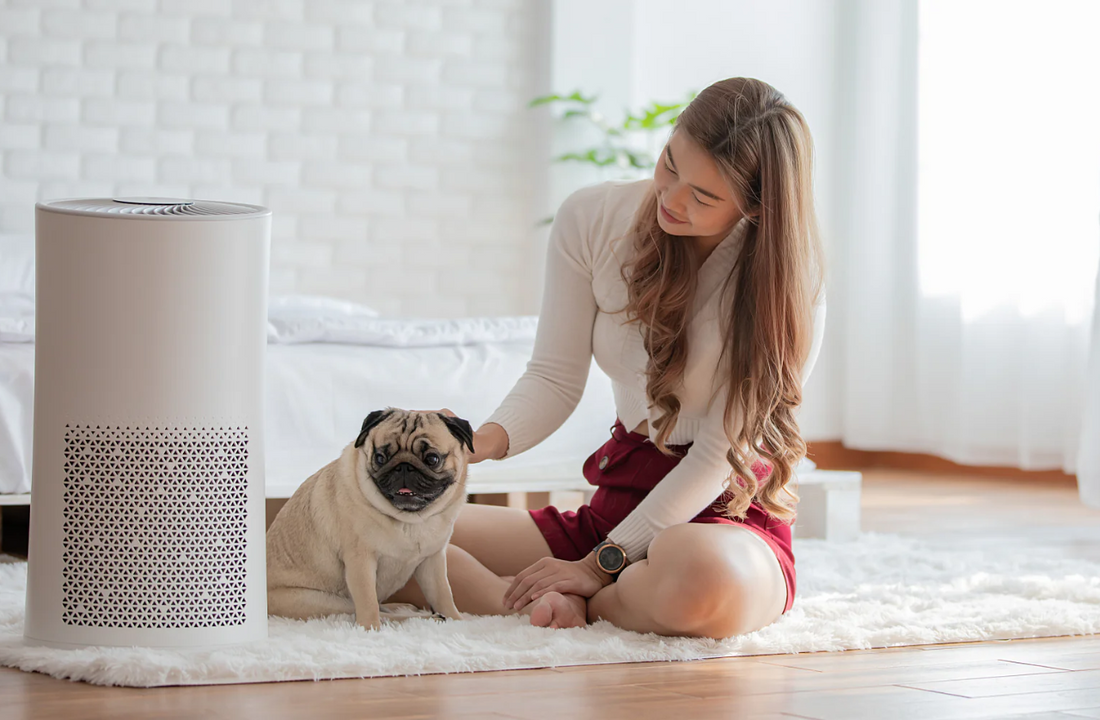Pet allergies and dander can be challenging for many households, especially where pets are part of the family. Pet dander, tiny flakes of skin shed by animals, often triggers allergic reactions and can stay airborne for hours. This dander, along with other pet-related allergens from saliva and urine, circulates through the air and settles on surfaces.
For people sensitive to these allergens, air purifiers offer a way to improve indoor air quality and reduce allergic symptoms. Wearable air purifiers like Hari Hats also provide portable protection, allowing individuals to manage exposure to allergens both at home and outdoors.
Understanding Pet Allergies
Pet allergies stem from proteins in pet dander, saliva, and urine, which provoke immune responses in sensitive individuals. Common symptoms include sneezing, itchy eyes, and congestion. Unlike other allergens, pet dander is very small and lightweight, allowing it to remain suspended in the air and enter respiratory passages, leading to allergic reactions over time. Effective air purifiers can help trap these particles, reducing the concentration of allergens in the air, though they don’t eliminate allergens on surfaces.
Effectiveness of Air Purifiers Against Pet Allergies and Dander
1. HEPA Filters: The Gold Standard for Allergen Removal
HEPA (High-Efficiency Particulate Air) filters are essential for capturing pet dander and other small particles. HEPA filters trap 99.97% of particles as small as 0.3 microns, effectively filtering pet dander and other airborne allergens out of the air. Hari Hats incorporates HEPA filtration, making it an effective choice for users seeking portable allergen protection, particularly in spaces where pets are present.
2. Role of Activated Carbon Filters in Odor Control
While HEPA filters excel at trapping particulate matter, activated carbon filters are useful for capturing odors from pet hair and litter boxes. Activated carbon adsorbs volatile organic compounds (VOCs) responsible for pet odors, improving the air’s freshness. This dual-layer filtration, which includes both HEPA and activated carbon, is commonly recommended for households with pets, as it controls both dander and odors.
3. Limitations of Ionizers and Ozone Generators
Ionizers and ozone generators are sometimes marketed as air purifiers, but they are less effective at removing pet dander and may produce ozone, which can irritate respiratory systems. Ionizers attempt to remove particles by charging them to settle on surfaces rather than filtering them out, but this approach does not address airborne allergens directly. In contrast, Hari Hats avoids ionization technology, focusing on reliable HEPA filtration without ozone emissions, ensuring safe and effective allergen control.
Specific Studies and Research Findings
Research supports that HEPA-based air purifiers are among the most effective options for reducing pet allergens in indoor environments. Studies have shown that HEPA air purifiers can capture a significant portion of airborne dander, which helps reduce allergy symptoms for people sensitive to pets.
Choosing the Right Air Purifier for Pet Allergies
1. Key Features to Look For
When selecting an air purifier for pet allergies, prioritize a HEPA filter with a high Clean Air Delivery Rate (CADR) for particles, a powerful motor for effective air circulation, and a carbon filter for odor control. Hari Hats combines HEPA and activated carbon filtration, designed specifically to provide on-the-go allergen protection.
2. Recommended Brands and Models for Pet Owners
Many HEPA-based air purifiers on the market cater to pet owners, with models designed to handle dander, odors, and other allergens effectively. Portable options like Hari Hats offer versatility, allowing users to carry filtration protection wherever they go, making it a convenient solution for pet-sensitive individuals.
3. Comparing Costs and Maintenance Requirements
Regular filter replacement is key for any air purifier to maintain effectiveness. Pet-friendly air purifiers may require more frequent filter changes due to the high dander levels they capture, which is a consideration for maintenance costs.
Placement and Usage of Air Purifiers
1. Optimal Locations for Maximum Effectiveness
Place air purifiers in rooms where pets spend most of their time, such as living rooms or bedrooms, to capture dander at the source. For personal spaces, Hari Hats offers flexible placement by serving as a wearable purifier, ensuring allergen protection even in shared or pet-prone environments.
2. How Many Air Purifiers Do You Need?
Larger homes or spaces with multiple pets may require more than one purifier to effectively cover different areas. For users on the go, Hari Hats can supplement home air purifiers by offering continuous filtration outside the home or in specific areas of high exposure.
Other Strategies for Managing Pet Allergies
1. Regular Cleaning and Maintenance Tips
Routine cleaning, including vacuuming with HEPA-equipped vacuums, reduces the accumulation of dander on surfaces. Washing pet bedding frequently also minimizes allergens around the house.
2. Grooming Your Pets to Reduce Dander
Regular grooming can reduce shedding and dander production, especially with breeds prone to heavy shedding. This also helps prevent allergens from dispersing through the air.
3. Creating a Pet-Free Zone in Your Home
Designating certain areas, like the bedroom, as pet-free zones can reduce allergen exposure in critical spaces. Using Hari Hats in pet-allowed areas provides portable protection, making it easier to manage allergen exposure even when outside designated pet-free zones.
Conclusion
Air purifiers can significantly alleviate pet allergies by trapping airborne dander, odors, and other allergens, improving overall indoor air quality. HEPA and activated carbon filters are particularly effective for this purpose.
In addition to home-based purifiers, wearable air purifiers like Hari Hats offer a flexible solution, allowing allergy-sensitive individuals to manage pet allergens wherever they go. For more information on Hari Hats and their advanced air filtration capabilities, visit harihats.com.
